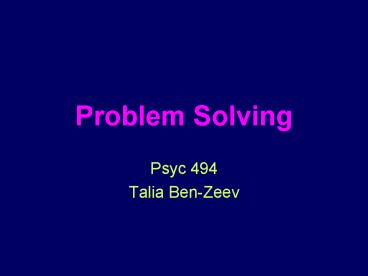Problem Solving - PowerPoint PPT Presentation
1 / 17
Title:
Problem Solving
Description:
Problem Solving. Psyc 494. Talia Ben-Zeev. When is a behavior an instance of problem solving? ... There are 26 sheep and 10 goats on a ship. How old is the captain? ... – PowerPoint PPT presentation
Number of Views:52
Avg rating:3.0/5.0
Title: Problem Solving
1
Problem Solving
- Psyc 494
- Talia Ben-Zeev
2
When is a behavior an instance of problem solving?
1. Goal directedness
2. Subgoal decomposition
3. Operator Selection
3
Types of Problems
- Well defined
- Ill defined
4
Ill defined problems
- How can we maximize our potential?
- How can we sustain a romantic relationship over
the long term?
5
Well defined problems
6
Well defined problems
- Monster Change Problem
- 3 monsters small, medium, and large.
- Small monster -- holding a medium globe.
- Medium monster -- holding a large globe
- Large monster -- holding a small globe
- Goal expand/shrink globes to fit monster size
- 1. Only one globe can be changed at a time
- 2. If two monsters have equal size globes, only
the larger monsters can be changed - 3. A globe cannot be changed to a size of a
larger monster
7
Rational Errors A window into problem solving
A hard problem 23 - 7 ??
8
More rational errors From counting to algebra
- Counting
- Twenty-five, Twenty-six, Twenty-seven,
Twenty-eight, Twenty-nine, (pause), ...
Twenty-ten! - Fractions
- 1/2 1/3 2/5
- Arithmetic Word Problems
- There are 26 sheep and 10 goats on a ship. How
old is the captain? - There are 125 sheep and 5 dogs in a flock. How
old is the shepherd?
9
More rational errors From counting to algebra
- Radicals
- Word Problems
- The number of quarters a man has is seven times
the number of dimes he has. The value of the
dimes exceeds the value of the quarters by two
dollars and fifty cents. How many has he of each
coin?
10
What is a rational error?
- A rational error results from a strategy
that is - rule-based
- internally consistent
- based on prior problem-solving experience
11
What is the origin of rational errors?
12
Addition in a new number system
13
The NewRoman number system
14
Two addition algorithms in NewRoman
15
Results from the NewRoman study
16
Results from the NewRoman study
17
Conclusion and Educational Implications
- Teaching for thinking How can we promote it?































